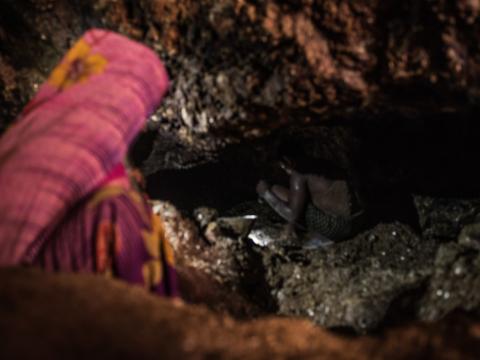Bihar, India

Deep in the forests reserve of Bihar state, six-year-old Roshni and her little brother Kamal, age 4, sit at the mouth of a cave picking tiny flakes of mica into a bowl. Their mother and father, Karan and Devi, are working deep inside the cave in a squatted position, collecting flakes of mica into a cane basket.
The cave is about six feet high and three feet wide at its mouth, and becomes smaller and narrower as it deepens, with barely enough height at the end to kneel. The cave is pitch dark except for the light from Karan and Devi’s torches. While one hand holds the torch, the other hand digs into the rocky, slushy earth in search of chunks of mica and rocks. They each toss a handful of rocks, mud, and mica into the cane basket, swiftly separate the rocks from the mica, and bury their hands into the earth to repeat the process. On an average day, the family collects 40 to 50 kilograms of mica. This amount, collected during a 12-hour day of working by Karan, Devi, Roshni and Kamal, will be sold for about $6.54.
This mine in Bihar is illegal, but it will continue to operate for as long as there is mica to be found. Before India’s Forest Conservation Act of 1980 was legislated to limit deforestation, there were over 700 mines in Bihar with more than 20,000 workers. Now, there are only 38 official mica mines in Bihar. All other mines, including the one where Roshni and Kamal work with their parents, are illegal. These mines are generally in remote parts of the state and are controlled by an independent mine operator. The mine operator identifies old mines and breaks them open using heavy equipment. Once the mine is open, the mica must be collected using bare hands rather than large machinery: if mica breaks into smaller pieces during the collection, it loses market value.

The mine operators employ people from nearby villages and communities. There are no alternate livelihood options in this area, and so, unless they wish to migrate to bigger cities in search of work, mica mining is their only option. At one point, Karan did migrate to Bangalore (over 2100 km away) to work as a daily wage labourer in the plastic scrap industry, but he soon returned home. “I couldn’t afford to take care of my expenses there and save enough to send money home as well. It was very difficult,” he says.
Now, Karan and Devi have left their two older children, Raj (8) and Shanthi (10), with their grandmother in the village, more than 30 km away from the mine. To reach the mine, Karan, Devi, Roshni and Kamal walk for three
to four hours through hilly forests. Like other families from their village, they live in a makeshift hut near to the mine.
“If we don’t stay in the forest, we have to spend three hours to come here and three hours to go back every single day,” says Devi, as she puts little Kamal to sleep and prepares a simple meal. “We won’t be able to collect enough mica to make enough money for the day. So, this is our only option.” They will continue to stay until the mines are completely empty. Neither Devi nor her husband have ever been to school. “I want my children to be educated; that is why I have put Raj and Shanti in school. But I can’t afford to send all four of them to school,” says Devi.
“I don’t want my children to go through life like me. I want them to make something of their lives...anything but this mica.”